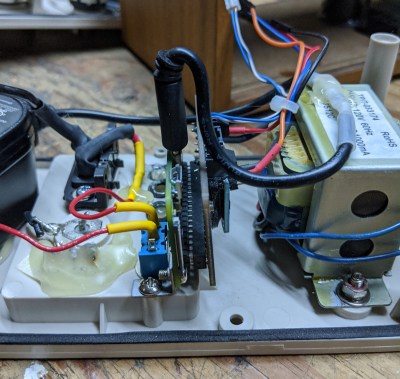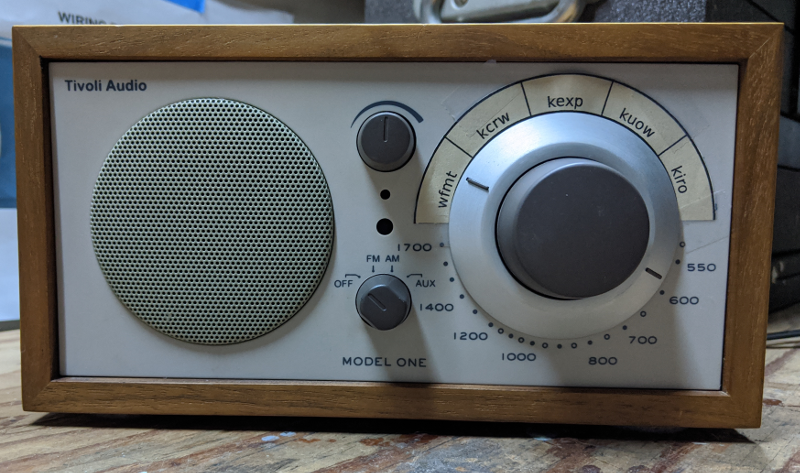While we have a definite sweet spot in our hearts for analog radio, there are times that just call for a digital upgrade. One of the downsides that can come with this upgrade is complexity. For example, the more software-minded among us might base their build on the Music Player Daemon, and use a web interface for control. But that’s not everyone’s idea of a good time, and particularly an older user of your gizmos might really appreciate a simple, tactile user interface. That’s the situation [Blake Hannaford] was in, while building an Internet powered radio for someone else.
 The solution was to take a familiar analog radio, the Tivoli Audio Model One, and give it a digital makeover. Now before you get worked up about wrecking the purity of a classic radio, note that the Model One is a faux-classic, made in 2000. No antiques were harmed in the making of this hack, and the exterior is essentially left stock — the only visible modification being the taped-on tuner label.
The solution was to take a familiar analog radio, the Tivoli Audio Model One, and give it a digital makeover. Now before you get worked up about wrecking the purity of a classic radio, note that the Model One is a faux-classic, made in 2000. No antiques were harmed in the making of this hack, and the exterior is essentially left stock — the only visible modification being the taped-on tuner label.
Inside it’s a Raspberry Pi Zero, the Adafruit Audio Bonnet, and a 3D printed bracket to tie a variable potentiometer to the tuning knob. The original volume knob and speaker are re-used. As [Blake] says, sometimes all you need is tuning and volume. Plus, re-using the speaker means that the whole unit still sounds great. Sometimes simple really is best.
While you’re here, check out our previous coverage of these style hacks and conversions!















The Tivoli was carefully designed by Henry Kloss. A cut above other radios. Might as well leave it.
There was an interview with Henry Kloss in Audio magazine, late eighties or nineties. He made the point that too many radios were designed for being out of town, so really sensitive but overloaded too easily. His radios were the reverse.
I have one of these and the sound is great, but the tuning is very, very fussy. We have a crowded FM band here in the Washington, DC, area and it’s hard to dial in my favorite station (which isn’t as strong as some of the others near it on the dial) and it drifts over time.
Oh, they re-used the speaker. I feel better now.
I would have fed the new audio source into the “aux” input, and found another way to handle the tuning. Perhaps a pot on the back.
Maybe that’s a good thing – as the box and speaker could be tuned for each-other. I tried to do a faux retro audio project and gave up because it sounded like sh!t. I was out of my league in terms of speaker/housing matching and balked at the idea of going down the Audio DSP rabbit hole.
And no, I didn’t watch the video. If that is how they routed the audio, then I give them props for that. Also, if they had made 5 small index marks on the tuning dial for the 5 digital stations, then they could do away with that janky paper label and leave it looking almost totally stock.
I always vow to stop commenting on Hackaday articles, but I just see so many things that could be done better, given a bit of thought.
Oh, there is no video. Sorry. There’s usually a video.
I’m rather shocked at the lack of modern touchscreens running RasPi and a cheap 150w 2.1 amplifier retrofitted into old Philco boxes. There are dozens of stripped out ones sold by radio repair shops on Marketplace…
That’s what I did. I built a few of these. On my Philco the volume pot was replaced with a rotary encoder for the volume. The one in my garage still works for AM (new caps and good tubes) so I left that intact. Under the hood is a pi with 55watt amplifier Hat that connects to a pair of Polk speakers. There’s a period correct knob on the side operated as a play/mute push button and volume control.
There’s also a small industrial touchscreen with a beagle board (it’s what I had) that interfaces to radio.
The next one will replace the round tuning indicator with a round LCD to display album art.
I’m still trying to figure out how to replicate tuning in stations with static as I switch “stations”.
The wife has requested that I build a touch-screen “jukebok” type with a big touch screen, modern 2.1 speaker amp, and modern speakers.
I’ve looked for other projects, and it surprised me to find very few of these documented.
Maybe I’ll do my very first HaD submission. 🤔
I think the problem is that the original power supply and tuning board are filling the inside of the radio, and findin space for an RPi and a DAC it’s a challenge. Not to mention that having the Pi near the AM circuits will mak them unusable due the interference. Tivoli makes DAB/Bluetooth/Wifi radios in the same form factor of the analogue model one, they moved the speaker upside and put button and a display on the front.
Anoter problem with that radio is the quality of the original variable tuning capacitor isn’t high quality, and tends after a couple of year of use, to make tuning difficult.
I think he was going to gut the original radio components and replace all except speaker and front panel.
I bought one of these at a yard sale. Unfortunately t it just makes a buzzing sound when it is turned on. I want to restore the original radio functionality. I think it is too gorgeous system to mod. Can anyone help with suggestions, schematics or documentation?
Suspect the filter electrolytic capacitor in the power supply has dried out and should be replaced. Please check the voltages with either an oscilloscope or a good volt meter – looking for an ac voltage ripple. Usually an inexpensive and ez fix.
I bought one of those Tivoli Audio Model Ones about 10 years ago to replace my dead Advent Model 400 FM radio that I bought about 44 years ago. The Advent Model 400 digital conversion would have been cooler but I tossed it in the electronic recycle at the dump.
Now that I listen to a lot of radio stations on the web I find new roadblocks to such elegant point the “dial” to WFMT Chicago’s fine arts station. Philadelphia’s WXPN ought to be here on that dial for us hackers. On any Sunday 01:00 to 06:00 Eastern for Stars End the finest electronic-space music on earth for over 40 years. A week or 2 ago they discontinued the simple stream that 1 click sends to VLC and thru phone or internet device to hear.
Now it’s off to their main website and prove your humanity to find the little button to start the stream. Phone in pocket is a no go to listen now. Tired of them pushing an APP to listen anyway.
There are the blind who have $$$ subsidized radios like this and they are getting screwed when standard streams are discontinued. It’s time for ADA accessibility to be maintained by Public Radio stations.
Sad truth, excellent point. Our digital obsession and the $ that drives it relies on visual screens and being a sighted end user. Definitely an ADA issue.
You could use the internetarchive command line ia to download from https://archive.org/details/starsend
That could be used in a script to play through an ADA compatible interface. Turn the knob and it would flip through available episodes, announcing using TTS and after short delay of not rotating knob, play streams.
I suspect the Tivoli is yet another chinese product with a British name on like my roberts radio which is a class is chinese product I still have a chinese intempo radio that is 17 years old the chinese make good radios